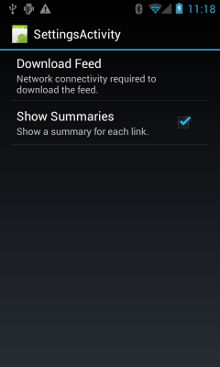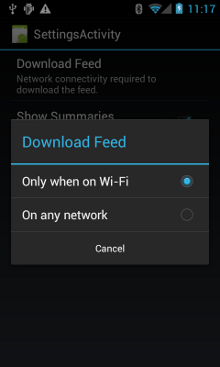This lesson describes how to write applications that have fine-grained
control over their usage of network resources. If your application performs a
lot of network operations, you should provide user settings that allow users
to control your app’s data habits, such as how often your app syncs data,
whether to perform uploads/downloads only when on Wi-Fi, whether to use data
while roaming, and so on. With these controls available to them, users are much
less likely to disable your app’s access to background data when they approach their
limits, because they can instead precisely control how much data your app
uses.
For general guidelines on how to write apps that minimize the battery life
impact of downloads and network connections, see
Optimizing Battery Life
and 无耗电地传输数据.
Check a Device's Network Connection
A device can have various types of network connections. This lesson
focuses on using either a Wi-Fi or a mobile network connection. For the full
list of possible network types, see
Wi-Fi is typically faster. Also, mobile data is often metered, which can get
expensive.
A common strategy for apps is to only fetch large data
if a Wi-Fi network is available.
Before you perform network operations, it's good practice to check the state of
network connectivity. Among other things, this could prevent your app from inadvertently using
the wrong radio. If a network connection is unavailable, your application
should respond gracefully. To check the network connection, you typically use
the following classes:
This code snippet tests network connectivity for Wi-Fi and mobile. It
determines whether these network interfaces are available (that is, whether
network connectivity is possible) and/or connected (that is, whether network
connectivity exists and if it is possible to establish sockets and pass
data):
private static final String DEBUG_TAG = "NetworkStatusExample";
...
ConnectivityManager connMgr = (ConnectivityManager)
getSystemService(Context.CONNECTIVITY_SERVICE);
NetworkInfo networkInfo = connMgr.getNetworkInfo(ConnectivityManager.TYPE_WIFI);
boolean isWifiConn = networkInfo.isConnected();
networkInfo = connMgr.getNetworkInfo(ConnectivityManager.TYPE_MOBILE);
boolean isMobileConn = networkInfo.isConnected();
Log.d(DEBUG_TAG, "Wifi connected: " + isWifiConn);
Log.d(DEBUG_TAG, "Mobile connected: " + isMobileConn);
Note that you should not base decisions on whether a network is
"available." You should always check
A more concise way of checking whether a network interface is available is as
follows. The method null if none if the
interfaces is connected (meaning that an
internet connection is not available):
public boolean isOnline() {
ConnectivityManager connMgr = (ConnectivityManager)
getSystemService(Context.CONNECTIVITY_SERVICE);
NetworkInfo networkInfo = connMgr.getActiveNetworkInfo();
return (networkInfo != null && networkInfo.isConnected());
}
To query more fine-grained state you can use
Manage Network Usage
You can implement a preferences activity that gives users explicit control
over your app's usage of network resources. For
example:
You might allow users to upload videos only when the device is connected to a
Wi-Fi network.
You might sync (or not) depending on specific criteria such as network
availability, time interval, and so on.
To write an app that supports network access and managing
network usage, your manifest must have the right permissions and
intent filters.
The manifest excerpted below includes the following permissions:
You can declare the intent filter for the
SettingsActivity, which displays a preferences UI to let users
decide when to download a feed.
package="com.example.android.networkusage"
...>
android:targetSdkVersion="14" />
...>
...
Implement a Preferences Activity
As you can see in the manifest excerpt above, the sample app's activity
SettingsActivity has an intent filter for the SettingsActivity is a subclass of
Whether to display summaries for each XML feed entry, or just a link for
each entry.
Whether to download the XML feed if any network connection is available,
or only if Wi-Fi is available.


Figure 1. Preferences activity.
Here is SettingsActivity. Note that it implements
refreshDisplay to true. This causes the display to refresh when the user
returns to the main activity:
public class SettingsActivity extends PreferenceActivity implements OnSharedPreferenceChangeListener {
@Override
protected void onCreate(Bundle savedInstanceState) {
super.onCreate(savedInstanceState);
// Loads the XML preferences file
addPreferencesFromResource(R.xml.preferences);
}
@Override
protected void onResume() {
super.onResume();
// Registers a listener whenever a key changes
getPreferenceScreen().getSharedPreferences().registerOnSharedPreferenceChangeListener(this);
}
@Override
protected void onPause() {
super.onPause();
// Unregisters the listener set in onResume().
// It's best practice to unregister listeners when your app isn't using them to cut down on
// unnecessary system overhead. You do this in onPause().
getPreferenceScreen().getSharedPreferences().unregisterOnSharedPreferenceChangeListener(this);
}
// When the user changes the preferences selection,
// onSharedPreferenceChanged() restarts the main activity as a new
// task. Sets the the refreshDisplay flag to "true" to indicate that
// the main activity should update its display.
// The main activity queries the PreferenceManager to get the latest settings.
@Override
public void onSharedPreferenceChanged(SharedPreferences sharedPreferences, String key) {
// Sets refreshDisplay to true so that when the user returns to the main
// activity, the display refreshes to reflect the new settings.
NetworkActivity.refreshDisplay = true;
}
}
Respond to Preference Changes
When the user changes preferences in the settings screen, it typically has
consequences for the app's behavior. In this snippet, the app checks the
preferences settings in onStart(). if there is a match between the setting and
the device's network connection (for example, if the setting is "Wi-Fi" and the
device has a Wi-Fi connection), the app downloads the feed and refreshes the
display.
public class NetworkActivity extends Activity {
public static final String WIFI = "Wi-Fi";
public static final String ANY = "Any";
private static final String URL = "http://stackoverflow.com/feeds/tag?tagnames=android&sort=newest";
// Whether there is a Wi-Fi connection.
private static boolean wifiConnected = false;
// Whether there is a mobile connection.
private static boolean mobileConnected = false;
// Whether the display should be refreshed.
public static boolean refreshDisplay = true;
// The user's current network preference setting.
public static String sPref = null;
// The BroadcastReceiver that tracks network connectivity changes.
private NetworkReceiver receiver = new NetworkReceiver();
@Override
public void onCreate(Bundle savedInstanceState) {
super.onCreate(savedInstanceState);
// Registers BroadcastReceiver to track network connection changes.
IntentFilter filter = new IntentFilter(ConnectivityManager.CONNECTIVITY_ACTION);
receiver = new NetworkReceiver();
this.registerReceiver(receiver, filter);
}
@Override
public void onDestroy() {
super.onDestroy();
// Unregisters BroadcastReceiver when app is destroyed.
if (receiver != null) {
this.unregisterReceiver(receiver);
}
}
// Refreshes the display if the network connection and the
// pref settings allow it.
@Override
public void onStart () {
super.onStart();
// Gets the user's network preference settings
SharedPreferences sharedPrefs = PreferenceManager.getDefaultSharedPreferences(this);
// Retrieves a string value for the preferences. The second parameter
// is the default value to use if a preference value is not found.
sPref = sharedPrefs.getString("listPref", "Wi-Fi");
updateConnectedFlags();
if(refreshDisplay){
loadPage();
}
}
// Checks the network connection and sets the wifiConnected and mobileConnected
// variables accordingly.
public void updateConnectedFlags() {
ConnectivityManager connMgr = (ConnectivityManager)
getSystemService(Context.CONNECTIVITY_SERVICE);
NetworkInfo activeInfo = connMgr.getActiveNetworkInfo();
if (activeInfo != null && activeInfo.isConnected()) {
wifiConnected = activeInfo.getType() == ConnectivityManager.TYPE_WIFI;
mobileConnected = activeInfo.getType() == ConnectivityManager.TYPE_MOBILE;
} else {
wifiConnected = false;
mobileConnected = false;
}
}
// Uses AsyncTask subclass to download the XML feed from stackoverflow.com.
public void loadPage() {
if (((sPref.equals(ANY)) && (wifiConnected || mobileConnected))
|| ((sPref.equals(WIFI)) && (wifiConnected))) {
// AsyncTask subclass
new DownloadXmlTask().execute(URL);
} else {
showErrorPage();
}
}
...
}
Detect Connection Changes
The final piece of the puzzle is the NetworkReceiver. When
the device's network connection changes, NetworkReceiver intercepts
the action wifiConnected and mobileConnected to true/false
accordingly. The upshot is that the next time the user returns to the app, the
app will only download the latest feed and update the display if
NetworkActivity.refreshDisplay is set to true.
Setting up a BroadcastReceiver that gets called unnecessarily can be a
drain on system resources.
The sample application registers the
NetworkReceiver in
in the manifest. When you declare a
in the manifest, it can wake up your app at any time,
even if you haven't run it for weeks. By registering and unregistering
NetworkReceiver within the main activity, you ensure that the app won't
be woken up after the user leaves the app.
If you do declare a in the manifest and you know exactly
where you need it, you can use
Here is NetworkReceiver:
public class NetworkReceiver extends BroadcastReceiver {
@Override
public void onReceive(Context context, Intent intent) {
ConnectivityManager conn = (ConnectivityManager)
context.getSystemService(Context.CONNECTIVITY_SERVICE);
NetworkInfo networkInfo = conn.getActiveNetworkInfo();
// Checks the user prefs and the network connection. Based on the result, decides whether
// to refresh the display or keep the current display.
// If the userpref is Wi-Fi only, checks to see if the device has a Wi-Fi connection.
if (WIFI.equals(sPref) && networkInfo != null && networkInfo.getType() == ConnectivityManager.TYPE_WIFI) {
// If device has its Wi-Fi connection, sets refreshDisplay
// to true. This causes the display to be refreshed when the user
// returns to the app.
refreshDisplay = true;
Toast.makeText(context, R.string.wifi_connected, Toast.LENGTH_SHORT).show();
// If the setting is ANY network and there is a network connection
// (which by process of elimination would be mobile), sets refreshDisplay to true.
} else if (ANY.equals(sPref) && networkInfo != null) {
refreshDisplay = true;
// Otherwise, the app can't download content--either because there is no network
// connection (mobile or Wi-Fi), or because the pref setting is WIFI, and there
// is no Wi-Fi connection.
// Sets refreshDisplay to false.
} else {
refreshDisplay = false;
Toast.makeText(context, R.string.lost_connection, Toast.LENGTH_SHORT).show();
}
}





















 5031
5031











 被折叠的 条评论
为什么被折叠?
被折叠的 条评论
为什么被折叠?








